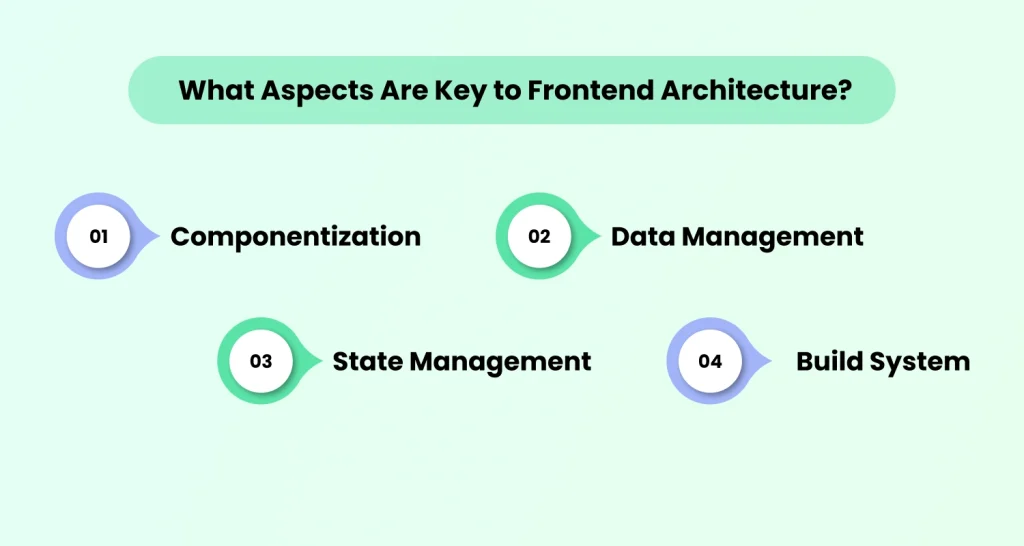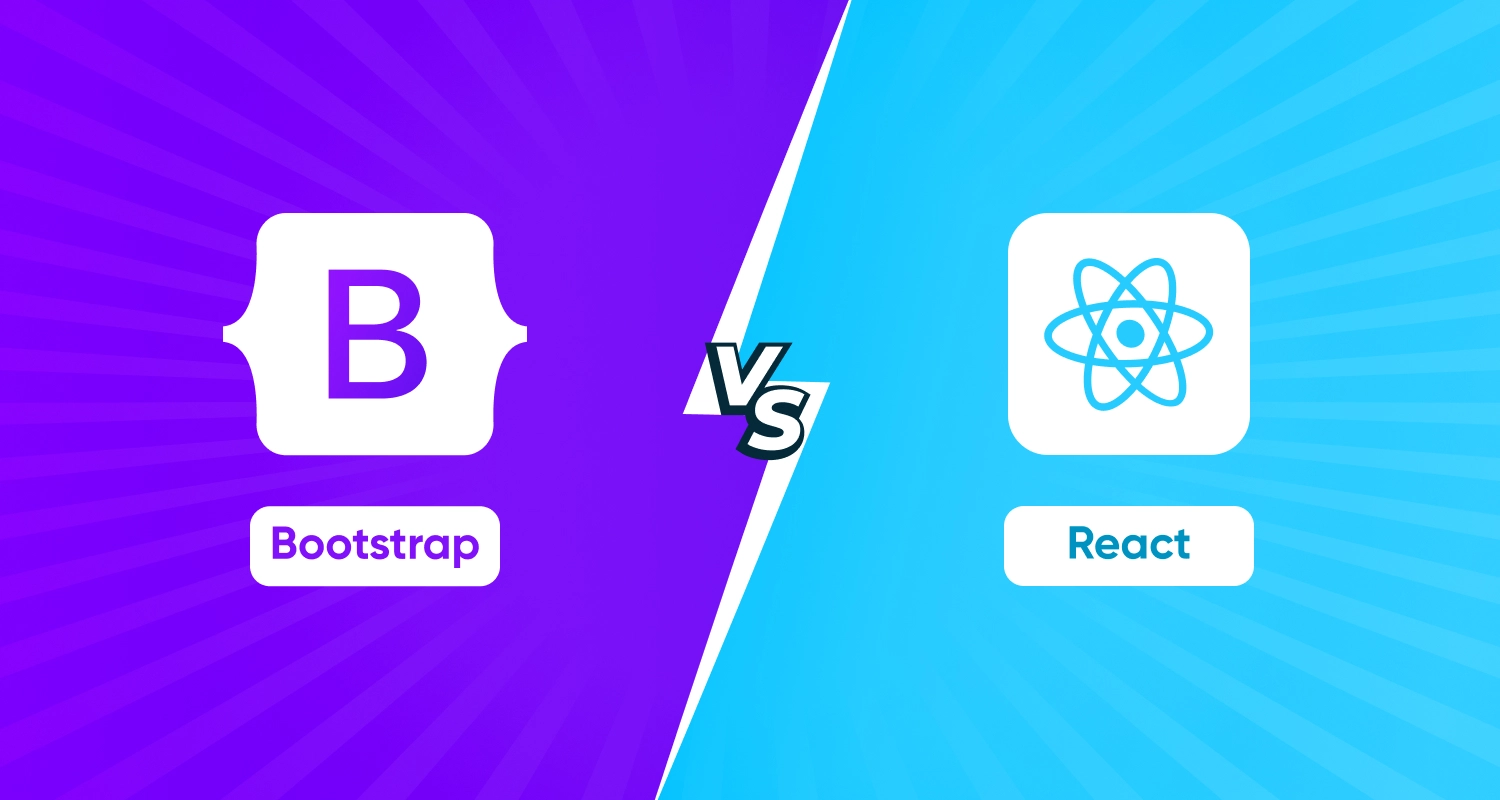Frontend architecture can be considered to be the backbone of any web application although most of the functionalities depend on the backend. But, why is this so? This is because when users open a web application, the first thing they see is the frontend architecture. If the design of the website is not attractive, they might not stay on it for too long. Always remember that a well-designed frontend architecture makes all the difference and is a quick way to make a lasting impression on users.
Often, businesses scale up and want to add new features to their web applications to better cater to user needs. But, formulating a new frontend architecture design is often difficult. A lot of businesses consider completely changing their tech stack to allow the addition of new features. You must be asking – won’t it be hectic? The truth is yes, the process can be quite hectic, which is why we are here with this article.
In the following article, we will discuss the key aspects of frontend architecture in detail and help you create a modern frontend architecture without much hassle. We will also help you understand how you can optimize the frontend design and architecture of your existing application. So, what are you waiting for? Jump right into this article to get started with learning the basics of frontend architecture and take a step towards optimization.
What Is Frontend Architecture All About?
Frontend architecture refers to the design and organization of the web application code that runs on the user’s web browser. We can consider it to be the foundation for creating well-structured, maintainable, and scalable web applications. When we refer to the frontend structure of a web application, we refer to the programming and design that help realize its user interface. Keep in mind that a well-designed frontend architecture affects how well the website functions and the user’s impression.
When building a frontend application architecture, you must consider the goals of the website, user preferences and needs, and the technologies that you can utilize. Taking these key factors into consideration will make the planning easier and help you better organize the web application architecture. It will also help identify future complications if any and allow you to better maintain your website.
Why Focus On Your Application’s Frontend Architecture?
In this following section, we will discuss why you must focus on your application’s frontend architecture. We will also discuss why it is a wise idea to redesign the frontend architecture of existing applications.
The first reason why you must hire an expert front-end architect to build or redesign the architecture of your web application is to establish coherence between the UI and UX. This is done by reducing the number of refreshes between views, selecting element sizes, designing the layout containing the interaction elements, and deciding on other elements to be added for greater accessibility. With a coherent UI and UX design, you can ensure that users are glued to your application and facilitate smoother user journeys.
Nowadays, an effective front-end design includes excellent image-based navigation, visual markers, welcoming space, and other elements that allow users to better use the web application. These web applications are undoubtedly more user-friendly than those congested with numerous elements and features. Some elements that you must focus on when redesigning the architecture of your web application include – white space, appealing color schemes, typography, interlinking of webpages, and other UI design principles.
What Aspects Are Key To Frontend Architecture?

Redesigning a web application’s frontend architecture can be quite complicated especially because there are a lot of factors that you must consider. In the following section, we will discuss the key aspects of frontend architecture to help you design a frontend clean architecture for your web application.
1. Componentization
One of the most important aspects of frontend architecture, componentization refers to the breaking down of the web application into small and reusable components. This is done to facilitate better organization of web elements, increased separation of concerns, and ease of maintenance. Componentization can be easily achieved with component-based frameworks like React and Vue.js.
2. State Management
It can be quite difficult to keep track of the different component states and their interaction with each other in a complex web application. This is where state management libraries which provide a centralized store for application states come in handy. With these libraries, management and updating of the behavior of different component states becomes easier.
3. Data Management
Unlike popular opinion, frontend architecture also involves a lot of data management. Some common examples include fetching, caching, and updating data from the APIs used in the web application. A great way to handle these processes is by using a library (a popular example is – Axios) for making local API calls and another (for example – LocalForage) to cache data.
4. Build System
A build system helps automate the complete process of code compilation and bundling which helps make it more efficient and easy to manage. A popular build system that is used quite widely is Webpack which is a tool that combines all code files and makes it easier to deliver them to a web server. Once we are done configuring it, no more customization or adjustment is necessary.
Other than considering these above-mentioned aspects, it is also necessary to take the complete application design and layout into account. This includes navigation, interaction between different elements, and the overall user experience. For those with little to no design and development experience, it can be difficult to focus on the numerous factors included in web app development. This is why we recommend building an expert design and development team for better results.
What Factors Should One Consider When Building A Frontend Architecture?
We have already discussed the different components that are key to frontend architecture. In this section, we will discuss the different factors that you must consider to build a great front-end architecture for your web application.
- Ensures that your web application delivers data in a way that is scalable. This means that you must ensure that any changes to the existing features or addition does not put extra strain on its functioning and the different parts of the system.
- Another important aspect of front-end architecture that helps you ensure the protection of the data and system from malicious users is security. You can include features like user authorization or implement multiple security protocols to develop a secure application.
- It is highly important to optimize your website’s performance which is often compromised when implementing multiple front-end development tools. If your website is not optimized properly, the load time can be quite high. With ever-decreasing user attention spans, it can be difficult to keep users on the website, and will lead to low retention rates.
What Are The Benefits Of A Well-Built Frontend Architecture?
It is quite clear that an application’s frontend architecture is critical to the user journey and customer conversion rates. But, are there any more benefits that you can reap with a well-built frontend architecture? To help you better understand the benefits of a clean, modern frontend architecture, we have listed them below. We recommend you hire front-end developers with years of experience to maximize your system’s potential to reap these benefits.
List of Key Advantages of a Well-Structured Frontend Architecture
- Improvement in Performance – When you implement modularity in your website and organize it in an efficient way, it is easier to find, load, and update them as changes are made.
- Faster Loading Times – With a modern layout where data management and other processes are taken care of, you can expect your website to have faster loading times. This helps boost user experience, better user journey and increases user satisfaction.
- Easier Maintenance and Scalability – To implement modularity, your team will divide the code into separate files. This allows developers to make changes to the code without worrying about its effect on other parts of the application.
- Better Reliability – With a well-structured frontend architecture, it is easy to ensure that all parts of the site are functioning effectively. Even when some parts of the website are being changed, it is easy to visualize whether the system is functioning as intended or not.
- Increased Security – A good frontend architecture can help reduce the risk of vulnerabilities like SQL injection attacks.
- Separation of Concerns – Since the application code is broken down into different parts, concerns are easily separated. It also makes it easier for the development team to figure out the issues with the code in case of any problems in the site functioning.
- Technology Independence – Due to the separation of the different parts of an application, it is easier to adopt different technologies. This also allows for greater flexibility and helps realize innovative ideas.

How Can You Optimize Your Application’s Existing Frontend Architecture?
Before we jump into front-end strategy examples, let us have a look at how you can optimize your existing web application’s frontend architecture. We have listed a few tips to help you get started with the optimization of your website’s frontend architecture:-
- Combine multiple files into one to minimize the total number of HTTP requests made. A common way to do this is to group your CSS and JS files into two main files while grouping all images used into one sprite.
- Minify your code to optimize it and ensure that it takes up less space on the server. This will enable faster transmission over the internet and help reduce page loading times.
- Integration of caching to allow users to visit your site and check out the different elements without having to download content. To perform cache integration, you can find a number of free tools for HTML as well as JavaScript files.
- Use Google Page Speed or other tools to analyze your page load times and find areas for concern. Then, you can make changes and speed up your website loading time which helps boost its performance.
Bonus – A Simple Example Of A Frontend Architecture Improvement Process
Company A measured their loading time and noticed that it was quite high. This resulted in higher bounce rates and less time on site. After careful checking, they found that their image files were quite large which was causing the issue with load time. To reduce page load times, they decided to compress the file size and ensure that the images did not lose their quality. Once done, they replaced the original images with these compressed versions. Now, users can not only view the content quickly but also do not miss out on high-quality visuals.
Final Words
The front-end architecture of a web application can have a huge effect on the website metrics and user journey. We hope the above article helped you learn how you can improve the design of your web application. If you have little to no design experience, we recommend getting in touch with a professional company offering front end development services. This will help take the burden off your shoulders while ensuring your users get access to an intuitive and modern user interface.
Frequently Asked Questions
What Tools and Frameworks Can Help in Frontend Architecture?
Some common tools and frameworks used in frontend architecture include:
Good text editors to write and edit code like Visual Studio Code and Atom.
Code framework to provide a structure of the code and speed up the development process.
A debugging tool to troubleshoot errors and find problems in the code.
Why Is Frontend Architecture Important?
A web application’s frontend architecture is the first thing a user sees when entering a website. It can make or break the user’s impression about the website which is why it is important to have a well-designed frontend architecture.
How Can I Improve Frontend Architecture?
There are a lot of ways in which you can improve the frontend architecture of your web application. To learn more, check out the above article that lists a few steps that you can adopt.
How to Design the Front End of a Website?
The design and development process of a web application’s frontend architecture can be quite complicated. Read the above article to learn about the different factors you need to consider and the key aspects of frontend architecture.
What Is the Impact of Progressive Web Apps (PWAs) On Frontend Architecture?
PWAs offer users the best of both web and mobile app technologies and help improve user experience. With PWAs, it is easy to provide users with a fast, seamless, and engaging experience.







